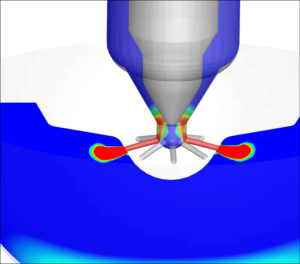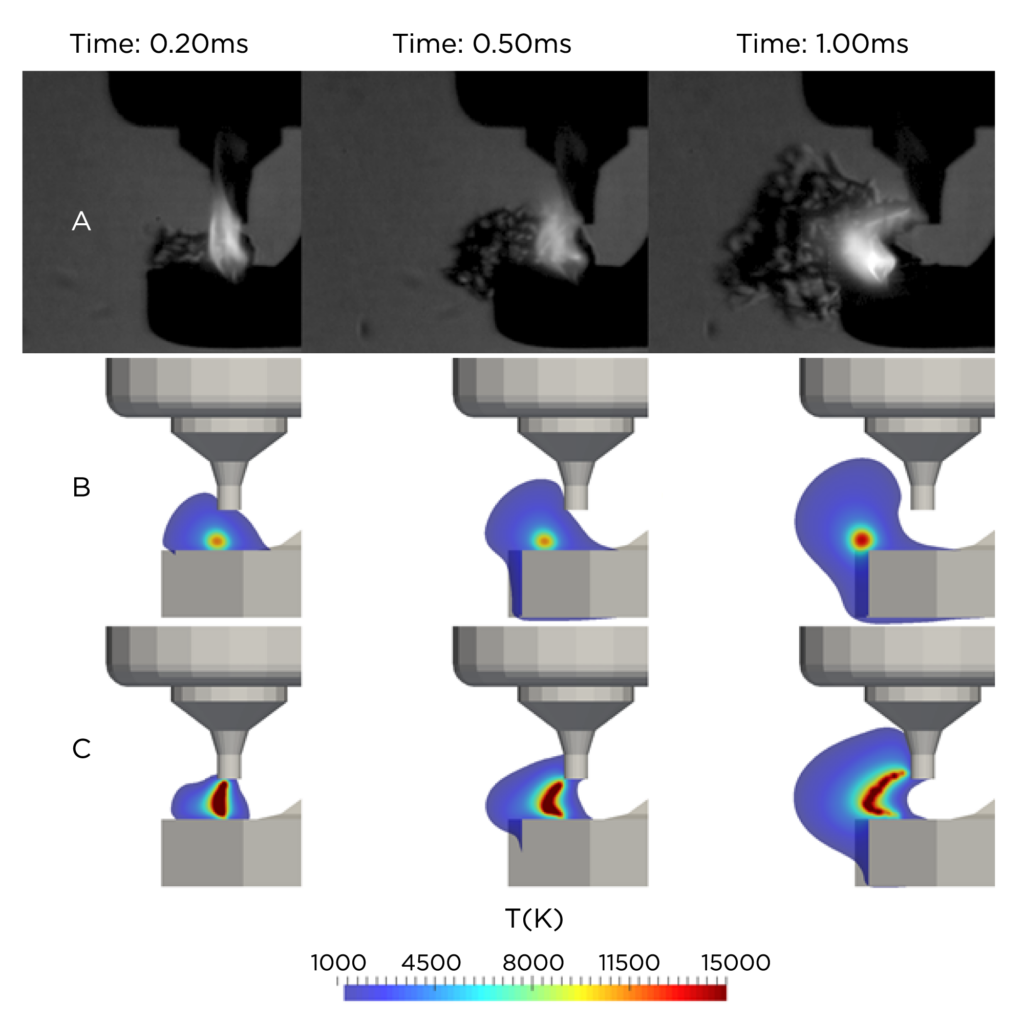
Author:
Elizabeth Favreau
Marketing Writing Team Lead
From the Argonne National Laboratory + Convergent Science Blog Series
Through the collaboration between Argonne National Laboratory and Convergent Science, we provide fundamental research that enables manufacturers to design cleaner and more efficient engines by optimizing combustion.
–Doug Longman, Manager of Engine Research at Argonne National Laboratory
The internal combustion engine has come a long way since its inception—the engine in your car today is significantly quieter, cleaner, and more efficient than its 1800s-era counterpart. For many years, the primary means of achieving these advances was experimentation. Indeed, we have experiments to thank for a myriad of innovations, from fuel injection systems to turbocharging to Wankel engines.
More recently, a new tool was added to the engine designer’s toolbox: simulation. Beginning in the 1970s and ‘80s, computational fluid dynamics (CFD) opened the door to a new level of refinement and optimization.
“One of the really cool things about simulation is that you can look at physics that cannot be easily captured in an experiment—details of the flow that might be blocked from view, for example,” says Eric Pomraning, Co-Owner of Convergent Science.
Of course, experiments remain vitally important to engine research, since CFD simulations model physical processes, and experiments are necessary to validate your results and ground your simulations in reality.
Argonne National Laboratory and Convergent Science combine these two approaches—experiments and simulation—to further improve the internal combustion engine. Two of the main levers we have to control the efficiency and emissions of an engine are the fuel injection system and the ignition system, both of which have been significant areas of focus during the collaboration.

The combustion process in an internal combustion engine really begins with fuel injection. The physics of injection determine how the fuel and air in the cylinder will mix, ignite, and ultimately combust.
Argonne National Laboratory is home to the Advanced Photon Source (APS), a DOE Office of Science User Facility. The APS provides a unique opportunity to characterize the internal passages of injector nozzles with incredibly high spatial resolution through the use of high-energy x-rays. This data is invaluable for developing accurate CFD models that manufacturers can use in their design processes.
Early on in the collaboration, Christopher Powell, Principal Engine Research Scientist at Argonne, and his team leveraged the APS to investigate needle motion in an injector.
“Injector manufacturers had long suspected that off-axis motion of the injector valve could be present. But they never had a way to measure it before, so they weren’t sure how it impacted fuel injection,” says Chris.
The x-ray studies performed at the APS were the first in the world to confirm that some injector needles do exhibit radial motion in addition to the intended axial motion, a phenomenon dubbed “needle wobble.” Argonne and Convergent Science engineers simulated this experimental data in CONVERGE, prescribing radial motion to the injector needle. They found that needle wobble can substantially impact the fuel distribution as it exits the injector. Manufacturers were able to apply the results of this research to design injectors with a more predictable spray pattern, which, in turn, leads to a more predictable combustion event.
More recently, researchers at Argonne have used the APS to investigate the shape of fuel injector flow passages and characterize surface roughness. Imperfections in the geometry can influence the spray and the subsequent downstream engine processes.
“If we use a CAD geometry, which is smooth, we will miss out on some of the physics, like cavitation, that can be triggered by surface imperfections,” says Sameera Wijeyakulasuriya, Senior Principal Engineer at Convergent Science. “But if we use the x-ray scanned geometry, we can incorporate those surface imperfections into our numerical models, so we can see how the flow field behaves and responds.”
Argonne and Convergent Science engineers performed internal nozzle flow simulations that used the real injector geometries and that incorporated real needle motion.1 Using the one-way coupling approach in CONVERGE, they mapped the results of the internal flow simulations to the exit of each injector orifice to initialize a multi-plume Lagrangian spray simulation. As you can see in Figure 1, the surface roughness and needle motion significantly impact the spray plume—the one-way coupling approach captures features that the standard rate of injection (ROI) method could not. In addition, the real injector parameters introduce orifice-to-orifice variability, which affects the combustion behavior down the line.

The real injector geometries not only allow for more accurate computational simulations, but they also can serve as a diagnostic tool for manufacturers to assess how well their manufacturing processes are producing the desired nozzle shape and size.

Accurately characterizing fuel injection sets the stage for the next lever we can optimize in our engine: ignition. In spark-ignition engines, the ignition event initiates the formation of the flame kernel, the growth of the flame kernel, and the flame propagation mechanism.
“In the past, ignition was just modeled as a hot source—dumping an amount of energy in a small region and hoping it transitions to a flame. The amount of physics in the process was very limited,” says Sibendu Som, Manager of the Computational Multi-Physics Section at Argonne.
These simplified models are adequate for most stable engine conditions, but you can run into trouble when you start simulating more advanced combustion concepts. In these scenarios, the simplified ignition models fall short in replicating experimental data. Over the course of their collaboration, Argonne and Convergent Science have incorporated more physics into ignition models to make them robust for a variety of engine conditions.
For example, high-performance spark-ignition engines often feature high levels of dilution and increased levels of turbulence. These conditions can have a significant impact on the ignition process, which consequently affects combustion stability and cycle-to-cycle variation (CCV). To capture the elongation and stretch experienced by the spark channel under highly turbulent conditions, Argonne and Convergent Science engineers developed a new ignition model, the hybrid Lagrangian-Eulerian spark-ignition (LESI) model.
In Figure 2, you can see that the LESI model more accurately captures the behavior of the spark under turbulent conditions compared to a commonly used energy deposition model.2 The LESI model will be available in future versions of CONVERGE, accessible to manufacturers to help them better understand ignition and mitigate CCV.

Ideally, every cycle of an internal combustion engine would be exactly identical to ensure smooth operation. In real engines, variability in the injection, ignition, and combustion means that not every cycle will be the same. Cyclic variability is especially prevalent in high-efficiency engines that push the limits of combustion stability. Extreme cycles can cause engine knock and misfires—and they can influence emissions.
“Not every engine cycle generates significant emissions. Often they’re primarily formed only during rare cycles—maybe one or two out of a hundred,” says Keith Richards, Co-Owner of Convergent Science. “Being able to capture cyclic variability will ultimately allow us to improve our predictive capabilities for emissions.”
Modeling CCV requires simulating numerous engine cycles, which is a highly (and at times prohibitively) time-consuming process. Several years ago, Keith suggested a potential solution—starting several engine cycles concurrently, each with a small perturbation to the flow field, which allows each simulation to develop into a unique solution.
Argonne and Convergent Science compared this approach—called the concurrent perturbation method (CPM)—to the traditional approach of simulating engine cycles consecutively. Figure 3 shows CCV results obtained using CPM compared to concurrently run cycles, which you can see match very well.3 This means that with sufficient computational resources, you can predict CCV in the amount of time it takes to run a single engine cycle.

The study described above, and the vast majority of all CCV simulation studies, use large eddy simulations (LES), because LES allows you to resolve some of the turbulence scales that lead to cyclic variability. Reynolds-Averaged Navier-Stokes (RANS), on the other hand, provides an ensemble average that theoretically damps out variations between cycles. At least this was the consensus among the engine modeling community until Riccardo Scarcelli, a Research Scientist at Argonne, noticed something strange.
“I was running consecutive engine cycle simulations to move away from the initial boundary conditions, and I realized that the cycles were never converged to an average solution—the cycles were never like the cycle before or the cycle after,” Riccardo says. “And that was strange because I was using RANS, not LES.”
Argonne and Convergent Science worked together to untangle this mystery, and they discovered that RANS is able to capture the deterministic component of CCV. RANS has long been the predominant turbulence model used in engine simulations, so how had this phenomenon gone unnoticed? In the past, most engine simulations modeled conventional combustion, which shows little cyclic variability in practice in either diesel or gasoline engines. The more complex combustion regimes simulated today—along with the use of finer grids and more accurate numerics—allows RANS to pick up on some of the cycle-to-cycle variations that these engines exhibit in the real world. While RANS will not provide as accurate a picture as LES, it can be a useful tool to capture CCV trends. Additionally, RANS can be run on a much coarser mesh than LES, so you can get a faster turnaround on an inherently expensive problem, making CCV studies more practical for industry timelines.
The gains in understanding and improved models developed during the Argonne and Convergent Science collaboration provide great benefit to the engine community. One of the primary missions of Argonne National Laboratory is to transfer knowledge and technology to industry. To that end, the models developed during the collaboration will continue to be implemented in CONVERGE, putting the technology in the hands of manufacturers, so they can create better engines.
What can we look forward to in the future? There will continue to be a strong focus on developing high fidelity numerics, expanding and improving chemistry tools and mechanisms, integrating machine learning into the simulation process, and speeding up CFD simulations—establishing more efficient models and further increasing the scalability of CONVERGE to take advantage of the latest computational resources. Moreover, we can look forward to seeing the innovations of the last decade of collaboration incorporated into the engines of the next decade, bringing us closer to a clean transportation future.
In case you missed the other posts in the series, you can find them here:
[1] Torelli, R., Matusik, K.E., Nelli, K.C., Kastengren, A.L., Fezzaa, K., Powell, C.F., Som, S., Pei, Y., Tzanetakis, T., Zhang, Y., Traver, M., and Cleary, D.J., “Evaluation of Shot-to-Shot In-Nozzle Flow Variations in a Heavy-Duty Diesel Injector Using Real Nozzle Geometry,” SAE Paper 2018-01-0303, 2018. DOI: 10.4271/2018-01-0303
[2] Scarcelli, R., Zhang, A., Wallner, T., Som, S., Huang, J., Wijeyakulasuriya, S., Mao, Y., Zhu, X., and Lee, S.-Y., “Development of a Hybrid Lagrangian–Eulerian Model to Describe Spark-Ignition Processes at Engine-Like Turbulent Flow Conditions,” Journal of Engineering for Gas Turbines and Power, 141(9), 2019. DOI: 10.1115/1.4043397
[3] Probst, D., Wijeyakulasuriya, S., Pomraning, E., Kodavasal, J., Scarcelli, R., and Som, S., “Predicting Cycle-to-Cycle Variation With Concurrent Cycles In A Gasoline Direct Injected Engine With Large Eddy Simulations”, Journal of Energy Resources Technology, 142(4), 2020. DOI: 10.1115/1.4044766


